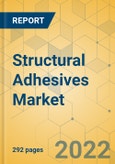Speak directly to the analyst to clarify any post sales queries you may have.
The structural adhesives market by revenue is expected to grow at a CAGR of over 6.59% during the period 2022-2027.
MARKET OPPORTUNITIES AND TRENDS
- Growing Demand from the Aerospace Industry
- Increasing Demand for Lightweight Vehicles
GLOBAL STRUCTURAL ADHESIVES MARKET SEGMENT ANALYSIS
Water-based technology adhesives are expected to project an absolute growth of over 56% from 2021 to 2027
Market Segmentation by Resin
- Acrylic
- Epoxy
- Polyurethane
- Cyanoacrylate
- Others
Market Segmentation by Technology
- Water-Based
- Solvent-Based
- Others
Market Segmentation by Substrates
- Composite
- Metal
- Wood
- Plastic
- Others
Market Segmentation by End-Users
- Building and Construction
- Automotive
- Aerospace
- Electrical and Electronics
- Wind Energy
- Marine
- Medical Devices
- Others
GEOGRAPHICAL ANALYSIS
In 2021, Europe was the second-largest consumer market for structural adhesives. The significant presence of global automotive manufacturers and the electronics industry is driving the demand for structural adhesives in the region
Market Segmentation by Geography
- North America
- US
- Canada
- Europe
- Germany
- UK
- France
- Italy
- Russia
- Turkey
- APAC
- China
- Japan
- India
- South Korea
- Indonesia
- Latin America
- Mexico
- Brazil
- Middle East and Africa
- UAE
- Saudi Arabia
- South Africa
VENDOR ANALYSIS
The parameters on which vendors are competing in the structural adhesives market are product portfolio, quality of the product, geographical presence, brand image, cost differentiation, and others.
Prominent Vendors
- 3M
- Henkel
- Sika
- B. Fuller
- Arkema (Bostik)
Other Prominent Vendors
- Ashland
- Dow Chemical Company
- Huntsman International
- Dymax
- Beacon adhesives
- PPG industries
- Parker Lord
- Infinity Bond
- Chemence
- Mapei
- DuPont
- Masterbond
- Akzo Nobel N.V.
- ITW Performance Polymers
- Uniseal
- Delo
- Soudal Group
- Scott Bader
- Parson Adhesives
- Panacol-Elosol-Gmbh
- Staloc
THE REPORT INCLUDES:
1. The analysis of global Structural Adhesives market provides market size and growth rate for the forecast period 2022-2027.
2. It offers comprehensive insights into current industry trends, trend forecast, and growth drivers about the global Structural Adhesives market.
3. The report provides the latest analysis of market share, growth drivers, challenges, and investment opportunities.
4. It offers a complete overview of market segments and the regional outlook of the Structural Adhesives market.
5. The report offers a detailed overview of the vendor landscape, competitive analysis, and critical market strategies to gain competitive advantage.
Table of Contents
Companies Mentioned
- 3M
- Henkel
- Sika
- B. Fuller
- Arkema (Bostik)
- Ashland
- Dow Chemical Company
- Huntsman International
- Dymax
- Beacon adhesives
- PPG industries
- Parker Lord
- Infinity Bond
- Chemence
- Mapei
- DuPont
- Masterbond
- Akzo Nobel N.V.
- ITW Performance Polymers
- Uniseal
- Delo
- Soudal Group
- Scott Bader
- Parson Adhesives
- Panacol-Elosol-Gmbh
- Staloc
Methodology
Our research comprises a mix of primary and secondary research. The secondary research sources that are typically referred to include, but are not limited to, company websites, annual reports, financial reports, company pipeline charts, broker reports, investor presentations and SEC filings, journals and conferences, internal proprietary databases, news articles, press releases, and webcasts specific to the companies operating in any given market.
Primary research involves email interactions with the industry participants across major geographies. The participants who typically take part in such a process include, but are not limited to, CEOs, VPs, business development managers, market intelligence managers, and national sales managers. We primarily rely on internal research work and internal databases that we have populated over the years. We cross-verify our secondary research findings with the primary respondents participating in the study.

LOADING...







